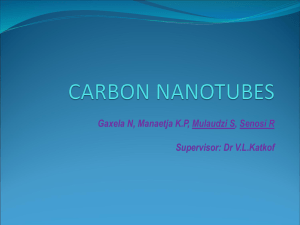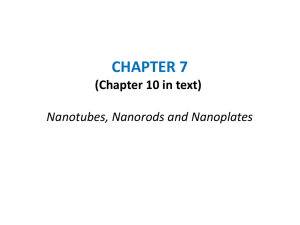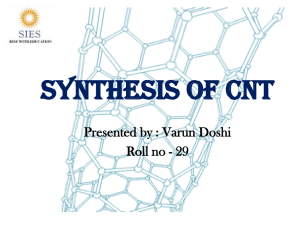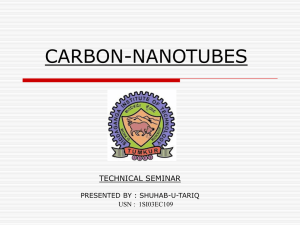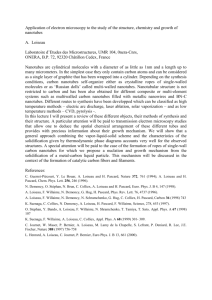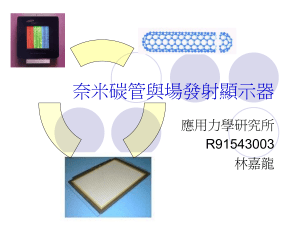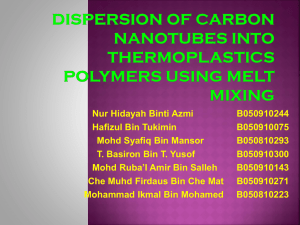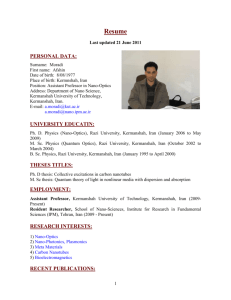Chiral-invariant electronic interactions in carbon nanotubes
advertisement
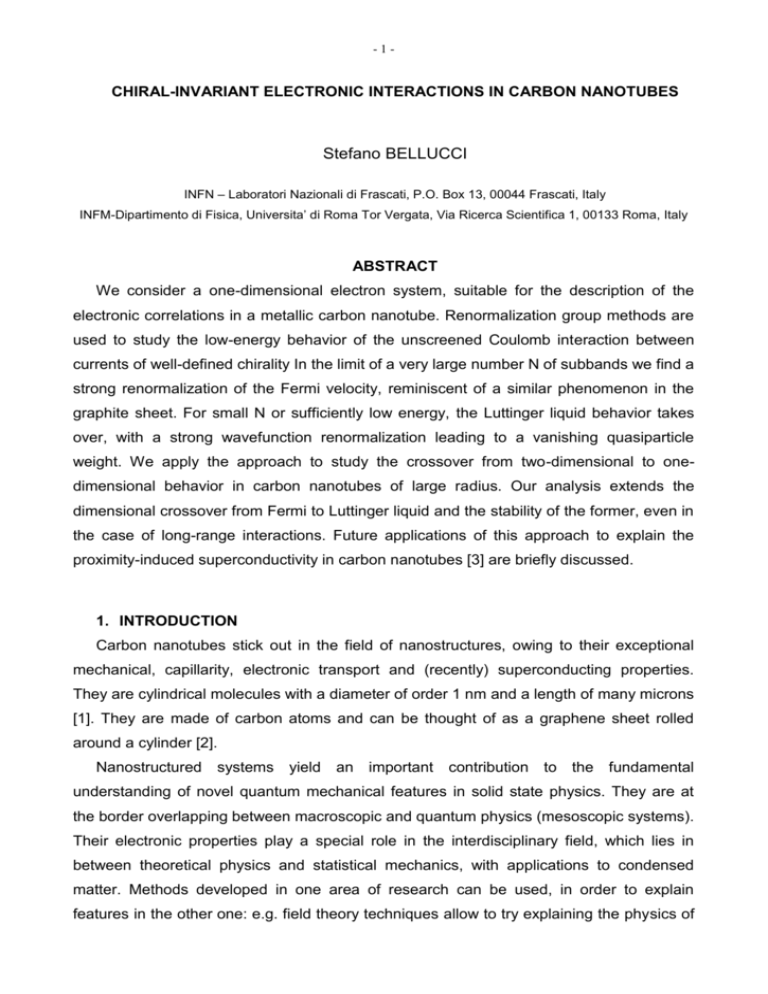
-1- CHIRAL-INVARIANT ELECTRONIC INTERACTIONS IN CARBON NANOTUBES Stefano BELLUCCI INFN – Laboratori Nazionali di Frascati, P.O. Box 13, 00044 Frascati, Italy INFM-Dipartimento di Fisica, Universita’ di Roma Tor Vergata, Via Ricerca Scientifica 1, 00133 Roma, Italy ABSTRACT We consider a one-dimensional electron system, suitable for the description of the electronic correlations in a metallic carbon nanotube. Renormalization group methods are used to study the low-energy behavior of the unscreened Coulomb interaction between currents of well-defined chirality In the limit of a very large number N of subbands we find a strong renormalization of the Fermi velocity, reminiscent of a similar phenomenon in the graphite sheet. For small N or sufficiently low energy, the Luttinger liquid behavior takes over, with a strong wavefunction renormalization leading to a vanishing quasiparticle weight. We apply the approach to study the crossover from two-dimensional to onedimensional behavior in carbon nanotubes of large radius. Our analysis extends the dimensional crossover from Fermi to Luttinger liquid and the stability of the former, even in the case of long-range interactions. Future applications of this approach to explain the proximity-induced superconductivity in carbon nanotubes [3] are briefly discussed. 1. INTRODUCTION Carbon nanotubes stick out in the field of nanostructures, owing to their exceptional mechanical, capillarity, electronic transport and (recently) superconducting properties. They are cylindrical molecules with a diameter of order 1 nm and a length of many microns [1]. They are made of carbon atoms and can be thought of as a graphene sheet rolled around a cylinder [2]. Nanostructured systems yield an important contribution to the fundamental understanding of novel quantum mechanical features in solid state physics. They are at the border overlapping between macroscopic and quantum physics (mesoscopic systems). Their electronic properties play a special role in the interdisciplinary field, which lies in between theoretical physics and statistical mechanics, with applications to condensed matter. Methods developed in one area of research can be used, in order to explain features in the other one: e.g. field theory techniques allow to try explaining the physics of -2- such quasi one-dimensional (1D) systems, which are connected to new surprising quantum properties of condensed matter. The exotic properties of carbon nanotubes, which can range from metallic to semiconducting ones, even with a large gap, allowing to consider them as molecular quantum wires, depend on two factors, i.e. the nanometric diameter of the tube and the peculiarities of the graphitic electronic structure [3]. Nanotubes are an exception to Peierls instability, which states the essential instability of unidimensional metallic wires, owing to the opening of a gap in the electronic energy at the Fermi energy, which turns them into semiconductors, as in the case of conducting polymers, e.g. polyacetilene [4]. Because of their special geometric and electronic band structure, nanotubes yield a protoype for single-molecule quantum wires. For large diameters one has a crossover from a purely 1D behavior to the 2D character of a graphene sheet. While thin single-walled nanotubes (SWNT) can be considered in the 1D limit, thick multi-walled nanotubes (MWNT) might instead fall in a 2D regime. We started out several years ago with a research line, which aims at clarifying both the electronic transport properties of carbon nanotubes, and allowed us to obtain and publish already interesting results. We report here an overview of our activity about nanostructured systems. 2. THEORETICAL ASPECTS AND ELECTRON CORRELATIONS IN SWNT There is much interest in the search of unconventional electron behavior deviating from the Fermi liquid picture [5]. The other paradigm that is well-established on theoretical grounds is the Luttinger liquid behavior of 1D electron systems [6]. In a 1D system, electrons do not form a Fermi liquid, which characterizes the customary state of a metal in the 3D world [7]. Instead, a liquid of correlated electrons is formed, which possesses unusual and peculiar features, e.g. spin and charge separation. Tomonaga and Luttinger, studying the effect of correlations in 1D electron liquids, found that they follow power laws. The theory of electron-electron correlation was then developed for carbon nanotubes, which can be represented as prototype 1D conductors [8]. In recent experiments on ropes of nanotubes, the electron spin has been shown to play a role in the transport through the tube, hence proving the relevance of electron correlations. A Luttinger signature can be observed in recent works about the power-law dependence of the conductance on the temperature and bias potential, with an increasing resistivity at low temperature [9] -3- The theoretical investigation we carried out on the electron-electron correlation effects so far, allowed us to explain various phenomena concerning transport properties and, more recently, also superconductivity in carbon nanotubes, in some cases even .preceding experimental observations. We showed several years ago that the Coulomb interaction in SWNT produces new effects, which deserve experimental investigation [10,11]. One of them concerns nanotubes with a radius large enough, to keep the same electronic properties of a single graphite sheet, as the energy decreases (at least down to a certain scale). A second phenomenologically interesting effect has to do with the transverse dimension, leading to scale-dipendent critical exponents. The resulting electron anomalous dimension grows, as the energy scale goes to zero. A first confirmation of the prediction comes from recent observations of the temperature dependence of the conductance at low bias [9]. In fact, such attempts to find Luttinger signatures in SWNT packed in the form of ropes, display deviations, in the low-temperature regime, from the power-law dependence typical of the Luttinger liquid behavior, which indeed agree with the suppression we predicted in the electron quasiparticles, and thus also in the electron density of states, at low energy [11]. Our work on electron transport in nanotubes will continue, aiming at a better understanding of the temperature dependence of the conductance, in view of possible improvements in its measurements. We recall from mesoscopic physics that one has single electron tunneling, when the capacitance of a conducting nanostructure is so small, that even adding a single electron requires an electrostatic charging energy larger than the thermal energy. Transport at low bias is then blocked, yielding a situation described as the so-called Coulomb blockade [12]. The anomalous increase we discovered in the intensity of the repulsive interaction at large distances, yields a quantitative evaluation of the effect of the Coulomb blockade mechanism in carbon nanotubes [11]. It will be necessary to measure the tunneling density of states and the conductance at even lower energy, in order to establish a quantitative relationship between the observed deviations from the scaling, and the long-ranged nature of the Coulomb interaction. 3. CRITICAL EXPONENT AND TUNNELING CONDUCTANCE IN MWNT This year we extended our model to MWNT, whose properties we investigated in connection with the physical observables of the tunneling conductance and critical exponents [13]. In connection with superconductivity in Cu-prates at high Tc, Anderson -4- suggested that the Luttinger model could be extended to two-dimensional systems, in the hope that it may explain some of the features of the copper-oxide materials [14]. However, the analytic continuation in the number D of dimensions has shown that the Luttinger liquid behavior is lost as soon as one departs from D = 1 [15]. Our investigation concerns the possibility that the long-range Coulomb interaction, owing to the singular long-ranged character, may lead to the breakdown of the Fermi liquid behavior at any dimension between D = 1 and D=2. The issue is significant for the purpose of comparing with a recent experimental observations of a power-law behavior of the tunneling conductance in MWNT [16]. These are systems whose description lies between that of a pure 1D system and the 2D graphite layer. It turns out, for instance, that the critical exponent measured for tunneling into the bulk of the multi-walled nanotubes is approximately 0.3. This value is close to the exponent found for the single-walled nanotubes in [9]. However, it is much larger than expected by taking into account the reduction due to screening (which goes like 1/N) in a wire with a large number N of subbands, what points towards sizeable effects of the long-range Coulomb interaction in the system. By developing an analytic continuation in the number of dimensions, and having in mind the low-energy modes of metallic nanotubes, we get a vanishing density of states at the Fermi level above D = 1. This ensures that the Coulomb interaction remains unscreened in the analytic continuation. At D = 2 we recover the low-energy description of the electronic properties of a graphite layer, dominated by the presence of isolated Fermi points. At this point we can solve the model in a self-consistent way, assuming basically the persistence a complete and unbroken chiral symmetry, which forbids any mixing through interactions between the two non-equivalent Fermi points common to the low-energy spectra of graphite layers and metallic nanotubes. On the other hand, it appears that nanophases with broken symmetry can only be realized, by doping the system about half-filling [17] or in a strong coupling regime [18]. Our solution determines the equivalence class that the model belongs to. In D=2 we are bound to recover the low-energy behavior of the model of Dirac fermions with the Coulomb interaction, whereas the 1D model exhibits a Luttinger liquid behavior, as it happens in the case of a short-range interaction. Hence we recover the anomalous dimension we found earlier in the solution of the Luttinger model [11]. We have therefore a model that interpolates between the marginal Fermi liquid behavior, that is known to characterize the 2D model, and a non-Fermi liquid behavior at D = 1. We conclude then -5- that, even in a model that keeps the Coulomb interaction unscreened, the breakdown of the Fermi liquid behavior only takes place formally at D = 1. In the vicinity of D = 1, a crossover takes place to a behavior with a sharp reduction of the electron quasiparticle weight. For values of D above 1.2 (approximately), we have a clear signature of quasiparticles at low energies. For lower values of D, the picture cannot be distinguished from that of a vanishing quasiparticle weight for all practical purposes. This picture allows us to make contact with the experiments carried out in MWNT. In the proximity of the D = 1 fixed-point, the density of states displays an effective power-law behavior, with an increasingly large exponent. Moving to the other side of the crossover, the density of states approaches the well-known behavior of the graphite layer. We observe that the exponents of the density of states at different dimensions are always larger than a lower bound of approximately 0.26, which is in agreement with the value measured experimentally. Our analysis stresses the need of an appropriate description of the dimensional crossover between one and two dimensions, showing that the picture of a thick nanotube as an aggregate of 1D channels does not allow to obtain the correct values of the critical exponents. 4. FUTURE DEVELOPMENTS: SUPERCONDUCTIVITY OF SWNT It is possible to improve the conductance of carbon nanotubes using doping, even at room temperature, through a mechanism whose origin is still unclear. One of the main motivations to introduce doping in such systems is the search for their possible superconductivity. Recent experimental observations by the groups of Kasumov and Bouchiat on superconductivity in molecular wires show the existence of supercurrents induced by proximity effects in undoped carbon nanotubes mounted across superconducting electrodes [19]. The dependence of the critical current on the temperature and magnetic field displays some unusual features that cannot be fully explained in terms of the customary BCS mechanism, but have to do rather with the strong 1D character of the samples. Our model appears to yield a natural explaination of such features, in terms of the effective reduction of interactions due to the long-range nature of the Coulomb interaction. Work is currently in progress and could be possibly extended to include Kasumov’s measurements on DNA molecules deposited across superconducting contacts (below 1 K). The DNA molecules can be metallic, down to a few mK, with a phase coherence maintained over a range a few hundreds of nanometers [20]. -6- ACKNOWLEDGEMENTS I wish to thank warmly the Organizers of the Workshop for a very stimulating atmosphere, and especially Giovanni Cuniberti for the kind invitation. PUBLICATIONS [1] R. Saito, G. Dresselhaus, M. S. Dresselhaus, “Physical Properties of Carbon Nanotubes”, Imperial College Press, London, 1998. [2] T. W. Ebbesen, Physics Today, 49 (1996) 26. [3] N. Hamada, S. Sawada, A. Oshiyama, Phys. Rev. Lett. 68 (1992) 1579; J. W. Mintmire, B. I. Dunlap, C. T. White, Phys. Rev. Lett. 68 (1992) 631. [4] R. E. Peierls, Ann. Phys. (Leipzig) 4 (1930) 121. [5] J. Gan, E. Wong, Phys. Rev. Lett. 71 (1993) 4226; C. Nayak, F. Wilczek, Nucl. Phys. B 417 (1994) 359; S. Chakravarty, R. E. Norton, O. F. Syljuasen, Phys. Rev. Lett. 74 (1995) 1423; J. Gonzalez, F. Guinea, M. A. H. Vozmediano, Nucl. Phys. B 485 (1997) 694. [6] J. Solyom, Adv. Phys. 28 (1979) 201; F. D. M. Haldane, J. Phys. C 14 (1981) 2585. [7] S.-I. Tominaga, Prog. Theor. Phys. (Kyoto) 5 (1950) 544; J. M. Luttinger, J. Math. Phys. 15 (1963) 609. [8] C. Kane, L. Balents, M. P. A. Fisher, Phys. Rev. Lett. 79 (1997) 5086. R. Egger, A. O. Gogolin, Phys. Rev. Lett. 79 (1997) 5082; ibid. Eur. Phys. J. B 3 (1998) 281. [9] M. Bockrath et al., Nature 397 (1999) 598; -7- Z. Yao et al., Nature 402 (1999) 273. [10] S. Bellucci, “Long-range interactions in a one-dimensional electron system”, Proc. Sixth Int. Conference on Path Integrals, Firenze 1998, Eds. R. Casalbuoni et al., (World Scientific, Singapore, 1999), p. 363, report hep-th/9810181. [11] S. Bellucci, J. Gonzalez, “On the Coulomb interaction in chiral-invariant onedimensional electron systems”, European Physical J. B 18 (2000) 3; S. Bellucci, “Electronic interactions in metallic carbon nanotubes”, Proc. Workshop Nanotubes&Nanostructures 2000, S. Margherita di Pula (Cagliari), Ed. S. Bellucci, (Compositori, Bologna 2001), (in press). [12] “Single Charge Tunneling: Coulomb Blockade Phenomena in Nanostructures”, Eds. H. Grabert, M. H. Devoret, (Plenum, New York, 1992). [13] S. Bellucci, J. Gonzalez, “Crossover from marginal Fermi liquid to Luttinger liquid behavior in carbon nanotubes”, Phys. Rev. B. (subm.), report cond-mat/0103558. [14] P. W. Anderson, “The Theory of Superconductivity in the High-Tc Cuprates”, (Princeton Univ. Press, Princeton, 1997). [15] C. Castellani, C. Di Castro, W. Metzner, Phys. Rev. Lett. 72 (1994) 316 [16] C. Schoenenberger et al., Appl. Phys. A 69 (1999) 283; A Bachtold et al., report cond-mat/0101306 [17] J. Gonzalez, F. Guinea, M. A. H. Vozmediano, Phys. Rev. B 63 (2001), to appear. [18] D. V. Khveshchenko, report cond-mat/0101306. [19] A. Yu. Kasumov et al., Science 284 (1999) 1508. [20] M. Kociak et al, report cond-mat/0010220.


